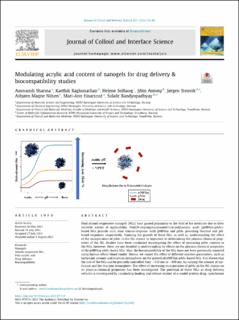| dc.description.abstract | Dual stimuli-responsive nanogels (NGs) have gained popularity in the field of bio medicine due to their versatile nature of applicability. Poly(N-isopropylacrylamide)-co-poly(acrylic acid) (pNIPAm-pAAc)-based NGs provide such dual stimuli-response with pNIPAm and pAAc providing thermal and pH-based responses, respectively. Studying the growth of these NGs, as well as, understanding the effect of the incorporation of pAAc in the NG matrix, is important in determining the physico-chemical properties of the NG. Studies have been conducted investigating the effect of increasing pAAc content in the NGs, however, these are not detailed in understanding its effects on the physico-chemical properties of the pNIPAm-pAAc-based NGs. Also, the biocompatibility of the NGs have not been previously reported using human whole blood model. Herein, we report the effect of different reaction parameters, such as surfactant amount and reaction atmosphere, on the growth of pNIPAm-pAAc-based NGs. It is shown that the size of the NGs can be precisely controlled from 130 nm to 400 nm, by varying the amount of surfactant and the reaction atmosphere. The effect of increasing incorporation of pAAc in the NG matrix on its physico-chemical properties has been investigated. The potential of these NGs as drug delivery vehicles is investigated by conducting loading and release studies of a model protein drug, cytochrome C (Cyt C) from the NGs at temperature above the volume phase transition temperature (VPTT) and acidic pH. An ex vivo human whole blood model was used to investigate biocompatibility of the NGs by quantifying inflammatory responses during NG exposure. The NGs did not induce any significant production of chemokine IL-8 or pro-inflammatory cytokines (IL-1, IL-6, TNF-), and the cell viability in human whole blood was maintained during 4 h exposure. The NGs did neither activate the complement system, as determined by low Terminal Complement Complex (TCC) activation and Complement Receptor 3 (CR3) activation assays, thereby overall suggesting that the NGs could be potential candidates for biomedical applications. | en_US |

